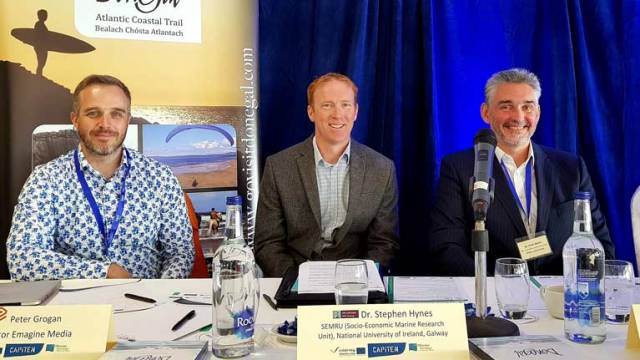Over six million visitors to Ireland visited a coastal area last year and almost five million of them took part in a marine-related activity, a study by NUI Galway has found writes Lorna Siggins
Most popular water-based activities were sea swimming, sea angling and different types of recreational boating, the study by NUI Galway’s (NUIG) Socio-Economic Marine Research Unit has found.
The report, which aimed to estimate what proportion of total holiday expenditure was in coastal areas and what proportion was on undertaking marine-related leisure activities, has valued total overseas coastal tourism spend at 1.9 billion euro, with marine activities for overseas visitors generating some €650 million.
Some 76% of overseas visitors to Ireland in 2018 are estimated to have visited a coastal area (as in 6.06 million people) and 61% of them are estimated to have participated in a marine-related activity (4.87 million people).
The average total expenditure per travelling party of overseas visitors in the sample was €1,630, with the average trip lasting seven days. Of this, an estimated €699 was spent in coastal areas.
The survey found that estimated total expenditure per person was €569, with an estimated 244 euro per person in a coastal.
However, the estimated marine-related activity expenditure per person was €82, with only an average of €25 per person being spent on on-water activities.
The survey notes that those individuals in the sample who actively engaged in marine-based activities during their stay had a statistically significant higher total expenditure per trip (€710) than the total sample.
They also stayed on average 1.32 days more per trip compared to the average respondent in the sample, the survey found.
Not surprisingly, the Atlantic seaboard counties of Kerry, Galway and Clare were the most popular for coastal and marine tourism activities.
The survey found that some 69% of the sample were aware of the Wild Atlantic Way and had planned an average of 2.5 days on the route during their visit.
“Tracking overseas visitors’ marine related spending patterns is essential to understand and develop adaptive policy-making strategies that can respond to active tourists’ expectations in terms of leisure and tourism activities in these coastal areas,” Dr Stephen Hynes, co-author of the report and director of SEMRU at NUIG, notes.
The report also notes some challenges to the development of the overseas coastal tourism market and warns of the importance of maintaining competitiveness in relation to the British visitor market after Brexit.
NUIG’s Whitaker Institute director Professor Alan Ahearne said that “with Brexit likely to add to regional imbalances in this county, it is crucial for our economy that we continue to invest in coastal and marine tourism product and infrastructure to attract tourists from abroad”.
The report was released at the Donegal Marine Tourism Conference, which is taking place in Inishowen on September 5th and 6th.





























































